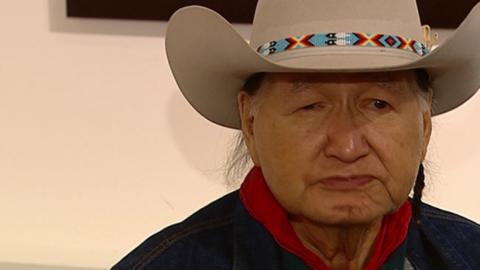 |
Canku Ota
|
 |
|
(Many Paths)
|
||
|
An Online Newsletter
Celebrating Native America
|
||
|
January 2016 - Volume
14 Number 1
|
||
|
|
||
|
'Grandfather Of Saskatchewan
Art' Allen Sapp Dies At Age 87
|
||
|
by CBC News
|
||
|
Sapp grew up on
the Red Pheasant reserve in the 1930s
Dec 29, 2015 — One of Saskatchewan's most renowned artists died on Monday night. Allen Sapp, who grew up on the Red Pheasant reserve south of North Battleford in the 1930s, was 87 when he died in his sleep. Leah Garven, curator of North Battleford's Allen Sapp Gallery, said Sapp's smile is something she'll never forget. "He was generally always happy," Garven said. "I
saw him I think just prior to Christmas and he seemed very happy
and always had a smile to share with somebody. He was very giving."
Sapp always painted what he knew and his paintings continue to tell stories from his life and the lives of those he loved most. "He was very connected to his culture and responded very well to his culture right up until his last days," Garven said. "His work is a real personal account of his life growing up on the Red Pheasant reserve. I find it very diverse in his approach. He's documented a rich legacy in Saskatchewan — a cultural legacy and an historic one." Through his depiction of life on the reserve, Sapp was one of the first Cree artists to open up a whole new world for many art lovers. "It brought some notoriety and recognition to the Cree people that they were proud of," Garven said. "It was also a sense of pride. I've had some First Nation artists refer to Allen as, 'Allen Sapp: The grandfather of Saskatchewan art.' 'An appreciation for simpler times'
When Sapp was 14, he fell ill with spinal meningitis. After slowly recovering from the illness, he lost four of his seven brothers and sisters during the Great Depression. Sapp wanted to leave the reserve and move to North Battleford, but couldn't for another decade. After all those years, he held his first major exhibition in 1969 in Saskatoon. Reflecting on Sapp's work as whole, Garven said she finds it both very realistic and impressionistic at the same time. "The era that he painted or recorded or he recalled was
a very tough time in Saskatchewan history." Sapp is a descendant of legendary Cree leader Poundmaker. He never learned to read or write, but enjoyed drawing pictures. Garven believes those pictures he loved to create were so important because he often recorded a very tough time in Saskatchewan history.
"People were very poor generally — let alone on the reserve," she said. "Despite those challenges and obstacles, when you look at his work, you certainly get that undertone of celebration and contentment — an appreciation for simpler times." His 'tremendous' ability to paint from memory was vital for all who viewed his art, Garven said. "The fact that he could open insight to the whole world of what life was like on the plains or on Red Pheasant reserve allowed people in who had an interest in indigenous culture to learn more about it."
A timeline of excellence
|
|||||||
|
|
|
|
||
|
|
||
| Canku Ota is a free Newsletter celebrating Native America, its traditions and accomplishments . We do not provide subscriber or visitor names to anyone. Some articles presented in Canku Ota may contain copyright material. We have received appropriate permissions for republishing any articles. Material appearing here is distributed without profit or monetary gain to those who have expressed an interest. This is in accordance with Title 17 U.S.C. Section 107. | ||
|
Canku Ota is a copyright ©
2000 - 2015 of Vicki Williams Barry and Paul Barry.
|
||
 |
 |
|
|
The "Canku
Ota - A Newsletter Celebrating Native America" web site and
its design is the
|
||
|
Copyright ©
1999 - 2015 of Paul C. Barry.
|
||
|
All Rights Reserved.
|
||


